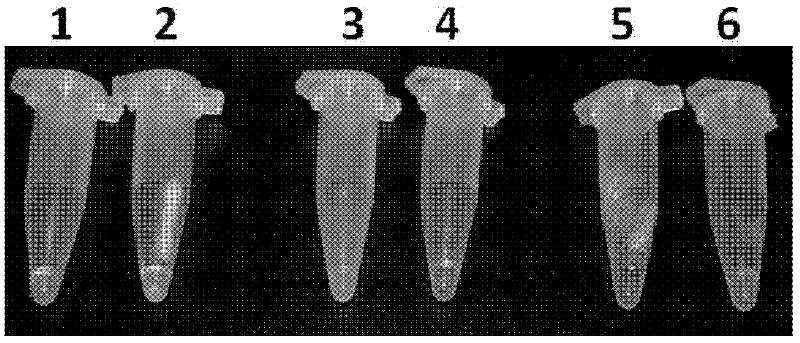Kit for detection of D. destructor in sweet potato based on loop-mediated isothermal amplification and its application
A ring-mediated isothermal and stem nematode technology, applied in the detection/testing of microorganisms, DNA/RNA fragments, recombinant DNA technology, etc., to achieve the effects of avoiding time loss, high positive rate, and low technical dependence
- Summary
- Abstract
- Description
- Claims
- Application Information
AI Technical Summary
Problems solved by technology
Method used
Image
Examples
Embodiment 1
[0054] Embodiment 1, the composition of kit
[0055] 1. Preparation of each component of the kit
[0056] 1. Preparation of primers
[0057] According to the rDNA-ITS region of D. destructor in sweet potato, the specific oligonucleotide primers were designed in the section where interspecific polymorphism existed. Three sets of primers were synthesized. The first set of primers consisted of universal outer primers (DdU-F3 and DdU-B3) and universal inner primers (DdU-FIP and DdU-BIP), and the second set of primers consisted of D. sweetpotato nematode-specific outer primers (DdA-F3 and DdA-B3), type A D. sweetpotato-specific inner primers (DdA-FIP and DdA-BIP) and type A D. sweetpotato-specific loop primers (DdA-LP and DdA-BP), the third group The primers consisted of type B D. sweetpotato nematode specific outer primers (DdB-F3 and DdB-B3) and type B D. sweet potato specific inner primers (DdB-FIP and DdB-BIP).
[0058] DdU-F3: 5'-AGTTGTATGCTTCTTTTTGTCC-3' (sequence 1 of the...
Embodiment 2
[0106] Embodiment 2, the application of kit
[0107] 1. Genomic DNA extraction
[0108] Genomic DNA of a single nematode was extracted from seven nematode experimental samples as follows:
[0109] 1. Add 20 μl of sample pretreatment solution to the cover glass, pick a single nematode in the sample pretreatment solution, squeeze the cover glass to rupture the worm body, and obtain the body fluid mixture; draw 10 μl of the body fluid mixture, and transfer it to a pre-installed 10 μl nematode. in a 1.5ml centrifuge tube of bacterial water.
[0110] 2. Quick freezing in liquid nitrogen for 1 minute, 65°C water bath for 20 minutes, and 95°C water bath for 5 minutes.
[0111] 3. Centrifuge at 12,000 rpm for 5 minutes, and take 5 μl of the supernatant as a reaction template (genomic DNA).
[0112] 2. Identify whether the sample to be tested is D. destructor of sweet potato
[0113] Genomic DNA extracted from 7 kinds of nematodes were subjected to LAMP reaction respectively.
[0...
Embodiment 3
[0125] Embodiment 3, the sensitivity detection of kit
[0126] 1. A small amount of genomic DNA extraction
[0127] Carry out the following steps with type A sweet potato D. destructor and B type D. rot:
[0128] 1. Collect freshly isolated D. destructor from sweet potato, centrifuge and wash in a 1.5ml centrifuge tube to form 10-20μL nematode pellet.
[0129] 2. Use tweezers to freeze the tube and pointed glass rod in liquid nitrogen for 30 seconds, and grind it into powder vigorously.
[0130] 3. Add 700 μL of DNA extraction buffer (containing 50 mM Tris-HCl, pH 7.5, 50 mmol / L NaCl, 5 mM EDTA, 0.5% SDS) and 7 μL of 20 mg / mL proteinase K, and mix gently.
[0131] 4. Put the tube in a 50°C water bath for 4-5h.
[0132] 5. Next, extract once with equal volumes of Tris saturated phenol and chloroform / isoamyl alcohol, and centrifuge at 12,000 rpm for 10 min.
[0133] 6. Take the supernatant into a new tube, add 0.1 times the volume of 3M NaAc (pH5.2) aqueous solution and 2.5 ti...
PUM
 Login to View More
Login to View More Abstract
Description
Claims
Application Information
 Login to View More
Login to View More - R&D
- Intellectual Property
- Life Sciences
- Materials
- Tech Scout
- Unparalleled Data Quality
- Higher Quality Content
- 60% Fewer Hallucinations
Browse by: Latest US Patents, China's latest patents, Technical Efficacy Thesaurus, Application Domain, Technology Topic, Popular Technical Reports.
© 2025 PatSnap. All rights reserved.Legal|Privacy policy|Modern Slavery Act Transparency Statement|Sitemap|About US| Contact US: help@patsnap.com



